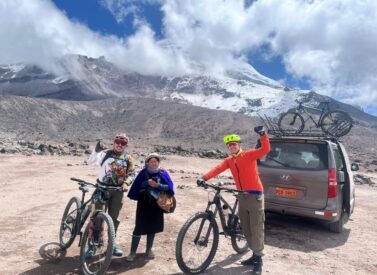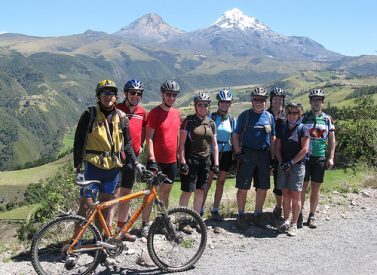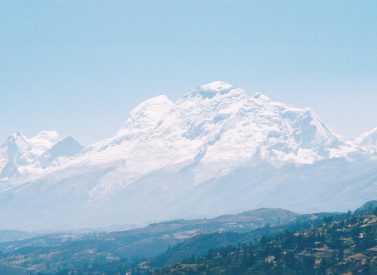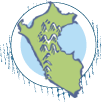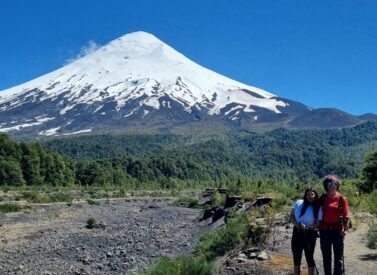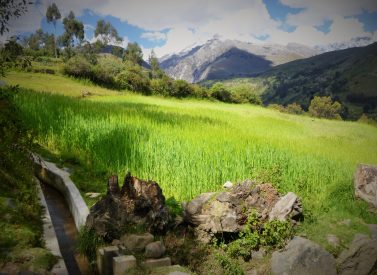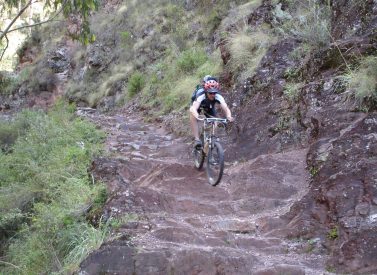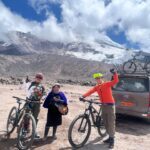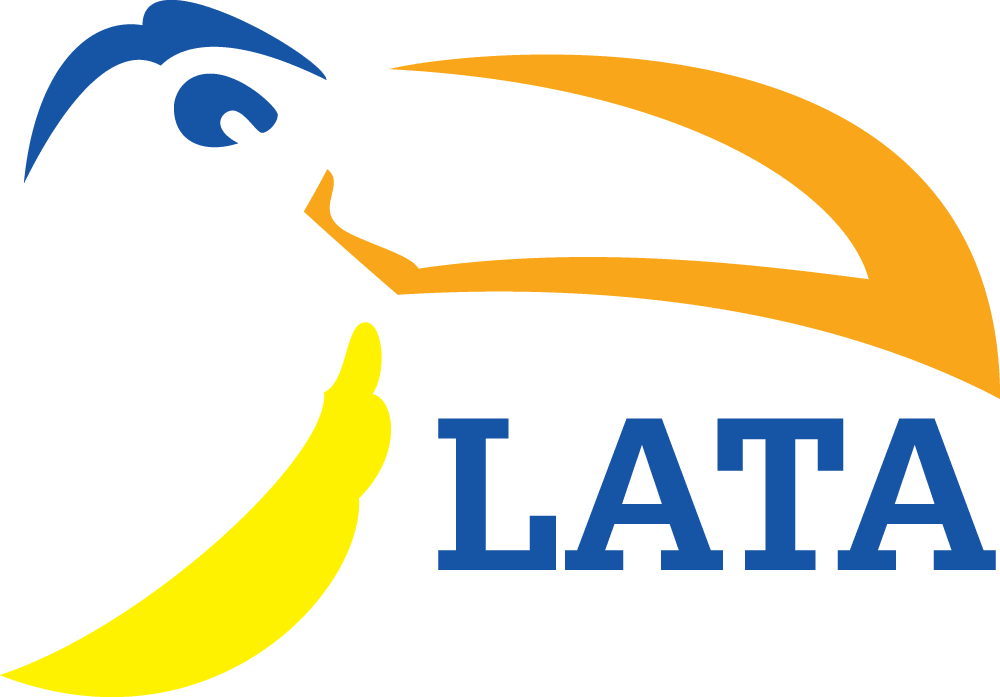Review: Mount Chimborazo Mountain Biking Tour
 by Tom Shearman on 22nd May, 2025
by Tom Shearman on 22nd May, 2025
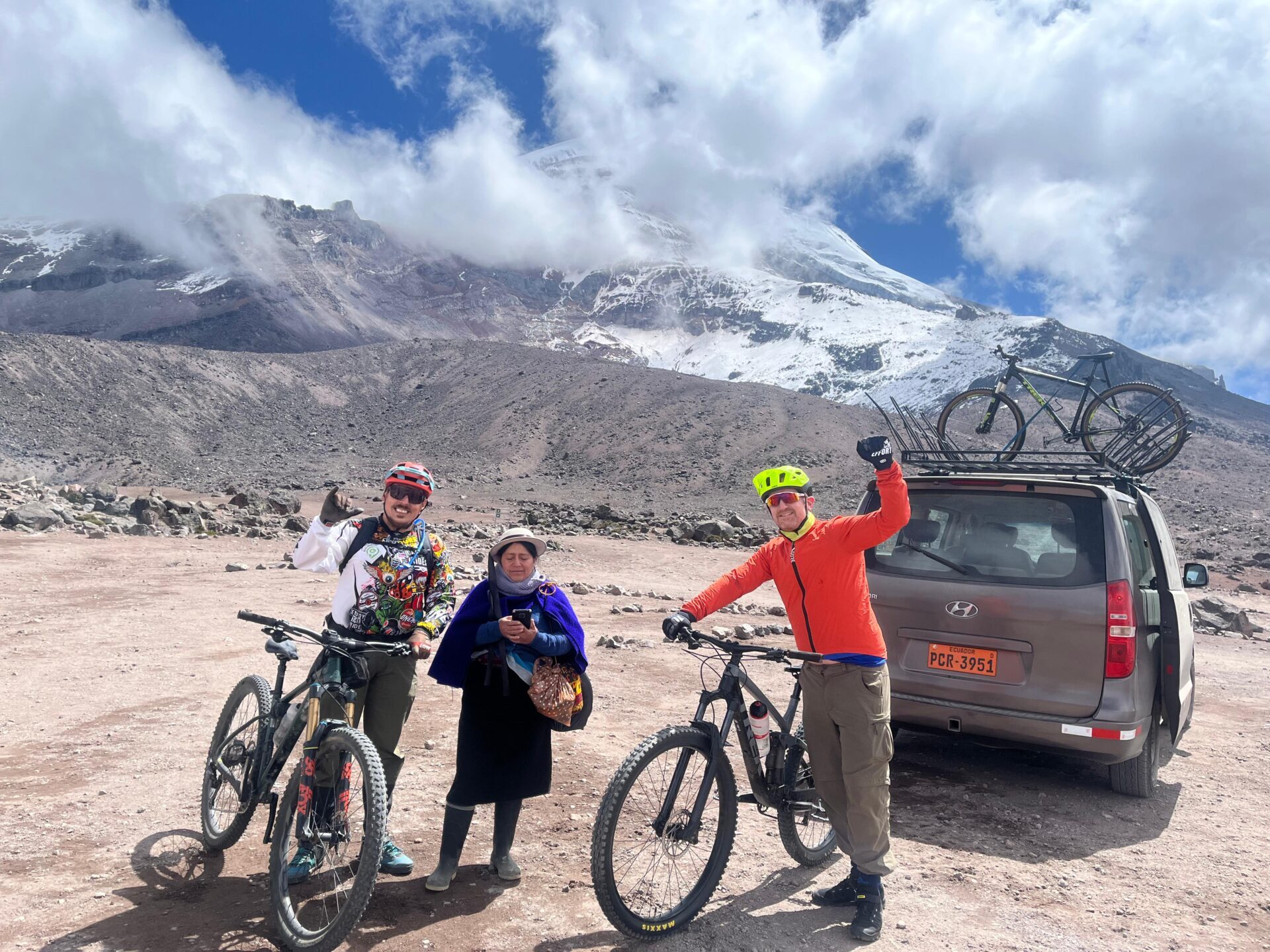
Mount Chimborazo Mountain Biking Tour.
It had been two decades since I’d done any downhill mountain biking.
Fortunately, a comeback ride MTBing down Ecuador’s highest volcano would quickly bring back the joyous thrill of downhill mountain biking, the closest I’ll ever feel to a condor swooping through the skies.
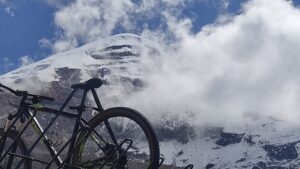
Mountain Biking Chimborazo
The Mount Chimborazo mountain biking tour is like a snapshot of Ecuador on one perfect riding day.
MTB riders decide how to tackle Ecuador’s highest mountain. Choose a super-fast descent or meander through volcanic moraines, taking in the spectacular views.
Various sections offer varied biking highlights:
- Start with a fast, technical, gravel ride on Chimborazo’s moraine.
- Tackle a sometimes technical sandy section—use the road if unsure.
- Enjoy a fast 2km downhill on tarmac.
- Take on a 30-minute climb that gives to an ancient Puruhá Trail, a pre-Inca civilisation whose descendants still inhabit the region.
- Weave through fertile farming land, with sheep, alpacas, cows, and Andean crops to see.
Chimborazo: The World’s Highest Peak
The heavily glaciated Mount Chimborazo is Ecuador’s highest peak at 6,310m/20,702ft. While not as high as Mount Everest (8,849m/29,032ft) and scores of other mountains, Chimborazo lies just 1.5 degrees south of an equator where the Earth’s centrifugal forces make the equator bulge out.
From sea level, Everest is much higher than Chimborazo. But that equatorial bulge means Chimborazo is almost four miles (6.8km) farther from the Earth’s core than Everest: Chimborazo’s peak is our home planet’s closest point to the Sun and stars.
With that in mind, I viewed the mountain with a changed celestial hue as a slow and sometimes bumpy 4×4 drive took us to the thin air of the Refugio Carrel car park. On the way up, our Puruhá guide, Magdalena, explained her people’s ancient connection with Chimborazo, its lands, and its connection to her culture.
We stepped out at 4,850m/15,912ft. The air here is so thin that it almost crackles, a hint to the stratosphere and the vacuum of space that drift above. Being at such heights increased not only my potential energy for the downhill but also my enthusiasm to start riding.
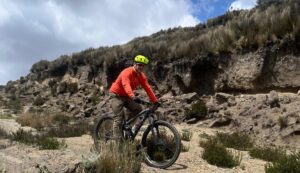
Chimborazo Downhill MTB: The Moraine
Magdalena sang us an enchanting traditional Puruhá song to keep us safe on our travels, a handclap rhythm with looping and high-pitched Andean folk strains.
The good fortune didn’t seem necessary for the first 30 metres as we coasted from the car park onto a signposted MTB track. Soft moraine provided extra cushioning already extravagantly afforded by my dual suspension trek MTB.
Things went downhill pretty quickly after that.
As in, very fast.
The moraine is a speedster’s paradise. In two miles (3.5km), you drop more than 500m/1,640ft from Chimborazo’s shoulders. This is why Chimborazo is a must for biking fans visiting Ecuador.
The single track weaves between occasional boulders, tufts, and stones. I knew I was going fast, possibly the fastest bike I’ve ever ridden. Within what felt like seconds, but it was probably a couple of minutes, we’d made it to the Chimborazo park entrance.
“We clocked seventy-five km/h,” my guide tells me. (47mph approx.)
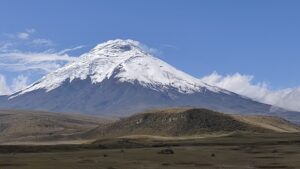
The Shifting Sands of Chimborazo
There was no time to absorb that stat before we pushed into a more technical section. Chimborazo isn’t all biking gifts. Its sandy sections offer a technical challenge, with shifting ground underneath, tight turns, and a few jump areas for those inclined. Anyone unsure can shadow the route on the road.
It was here that the first fall came—not a dramatic or sore one. Misjudging a tight curve, there wasn’t enough grunt, and my energy forces balanced perfectly to create a standstill point. With no other propulsion, the inevitable occurred: a slow, almost geriatric tilt to the left and a gentle but ego-bruising tumble.
The remaining sands offered interesting technical turns, small jumps, and some lung-bursting uphill. This section lasts half an hour or more, but the required concentration means it also flies past.
Roads and Puruhá Trail
With the thrilling and technical behind, it was time for a chilled tarmac descent. Speeds are consistently fast on the quiet tarmac road—we saw no vehicles—without touching the top speeds from earlier.
There’s a chance to relax in the saddle and enjoy the ever-changing views.
Chimborazo’s high and dry upper reaches give way to fertile grazing lands. Vicuñas, gifts from Chile to Ecuador, might be seen, or condors soaring ahead. Llamas, Andean foxes, and more wildlife may cross your path. There are climbing walls of La Chorrea, lodges, and signs of high-mountain life.
A 30-minute uphill ride along an ancient Puruhá Trail tests my acclimatisation and lungs. The Puruhá are an ancient civilisation that inhabited the Chimborazo region before the Spanish conquistadores arrived, revering Chimborazo. Only traces of the Puruhá exist in language, culture, and the road you briefly cycle over.
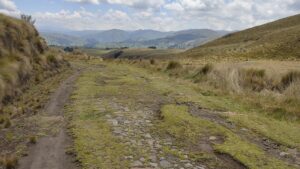
The Foothills of Chimborazo
The agricultural trails offer fast downhills with new mountain bike challenges: jumps, turns, bumps, and the occasional farmer. It was such a surprise meeting with a worker that led to my quick change of course into a cow pat and a slide into a hedge. Thanks to my protective gear and helmet, no harm was done, and the other gentleman was fine, other than a mildly strained rib caused by laughter.
Sweeping curves and a still-decent gradient mean the downhill mountain biking is still at a decent speed. Warmer air heats the bones after the stark contrast of the cold, high-mountain air.
The life cycle that starts with the water that trickles from Chimborazo’s glaciers invades the senses at lower altitudes. Rich, agricultural smells invade the nostrils. Vivid flowers, drowsy insects, and people working fields pass by as the cycling nears its end with a hearty lunch in a village, and a celebratory beer.
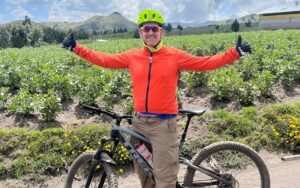
Mountain biking down Chimborazo was as exhilarating as it was fun. Meeting Magdalena added context to this giant volcano, which has sat silent for centuries. The bike ride provokes strong emotions in those who complete it; concentration, exertion, and Chimborazo’s natural beauty are a heady concoction in one, high-altitude day.
More Mountain Biking in Ecuador
Luckily, this was just one day among many in the saddle as part of my downhill mountain biking trip in Ecuador.
Alternatively, you can stay and climb Chimborazo or relax in one of the comfortable mountain lodges in the area. Day hikes, biking, and other outdoor activities are available.
Mountain Biking Chimborazo: Statistics
- Start at the Refugio Carrell (4,800m/15,750ft)
- Finish at Urbina (3,200m/10,170ft)
- Length: 25km/16miles
- Descent: 2,600m (8,530ft)
- Time: 3-5 hours descent
- Travel time: Two hours drive from Riobamba to the start point
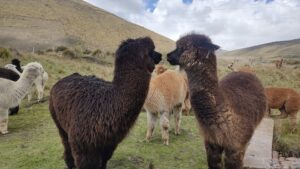
Frequently Asked Questions (FAQs)
Do I Need MTB Experience for This Trip?
This trip doesn’t need specific mountain bike experience, but it helps. We can tailor the day to your level. That said, you need to be comfortable riding a bike and expect to handle a mountain bike over various terrains, including downhill sections.
Do I Need a Guide?
Technically, you don’t need a guide for this trip. However, it will be very difficult to organise this day without using a guide and a tour agency. Organising the logistics (bike hire, 4×4, etc.), following the route, and ensuring safety are all concerns.
We recommend a guide to ensure your safety, know the best route, fix any mechanical issues, and make the day more enjoyable and instructive. They will also help pay for the entrance permit.
Will the Altitude Affect Me?
Our starting point is 4,800m/15,750ft, and much of the ride takes place over 4,000m/13,123ft. We recommend being well acclimatised before starting this tour, with 4-5 days minimum at altitudes over 3,000-4,000m/9,942-13,123ft.
Anyone not properly acclimatised may suffer altitude sickness and be unable to complete the ride.
What Clothes Should I Bring?
We provide a dual-suspension mountain bike, helmet, protective gear (elbow and knee pads), a boxed lunch, a guide, and transport.
High-mountain weather can be fickle. Winds, snow, and rain can occur at any time, especially at higher altitudes, so dress accordingly. You must bring cycling gloves, sunglasses, trousers, warm clothes (thermals, wick-away shirts), a rain and windproof jacket, sun cream, a water bottle, and snacks.
Review: Mount Chimborazo Mountain Biking Tour
Been inspired to try Chimborazo mountain biking? Contact us for more. And don’t leave it two decades between rides, either.
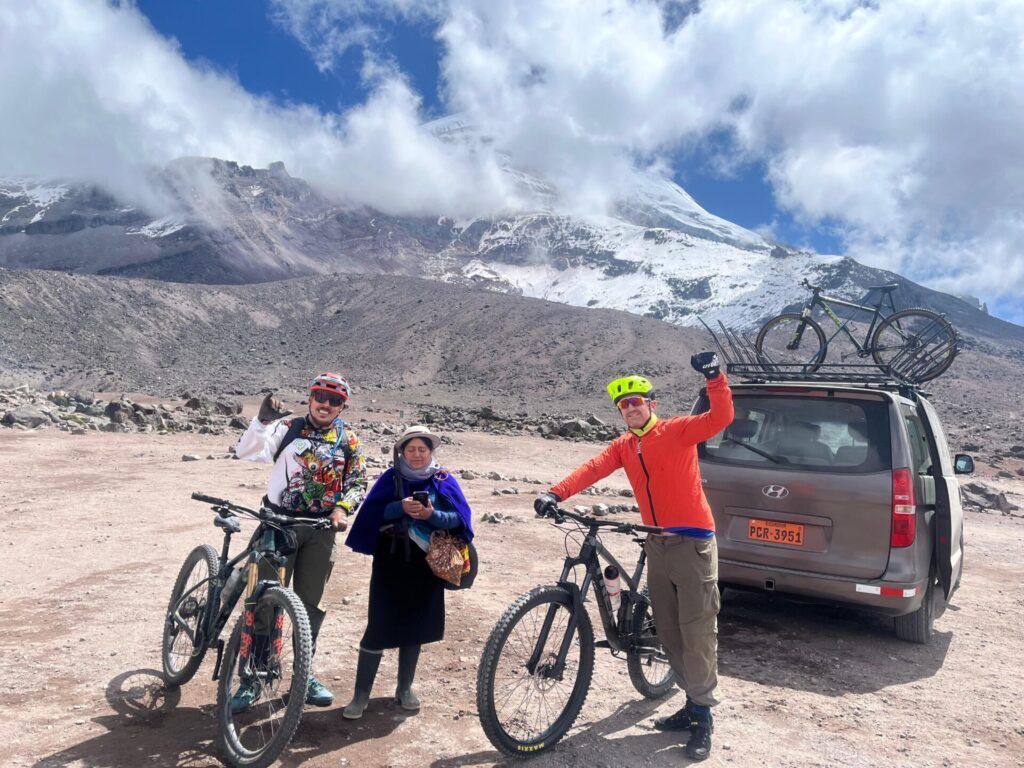
Share


 a Group Tour
a Group Tour  a Tailor Made Tour
a Tailor Made Tour 